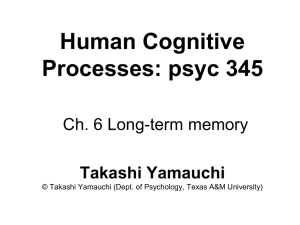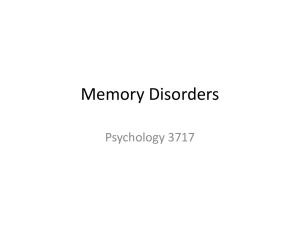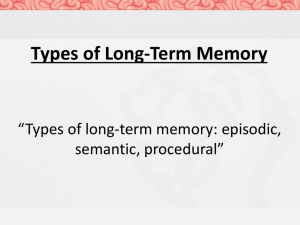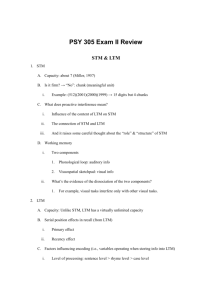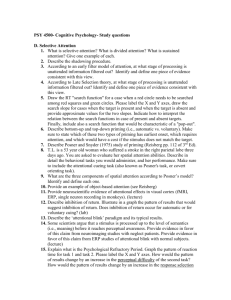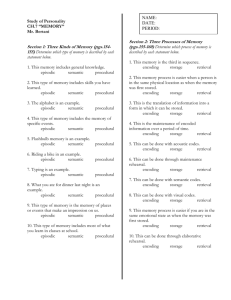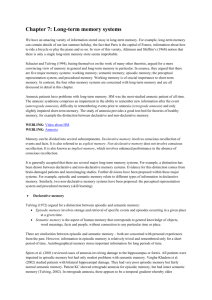Memory systems and the brain.
advertisement
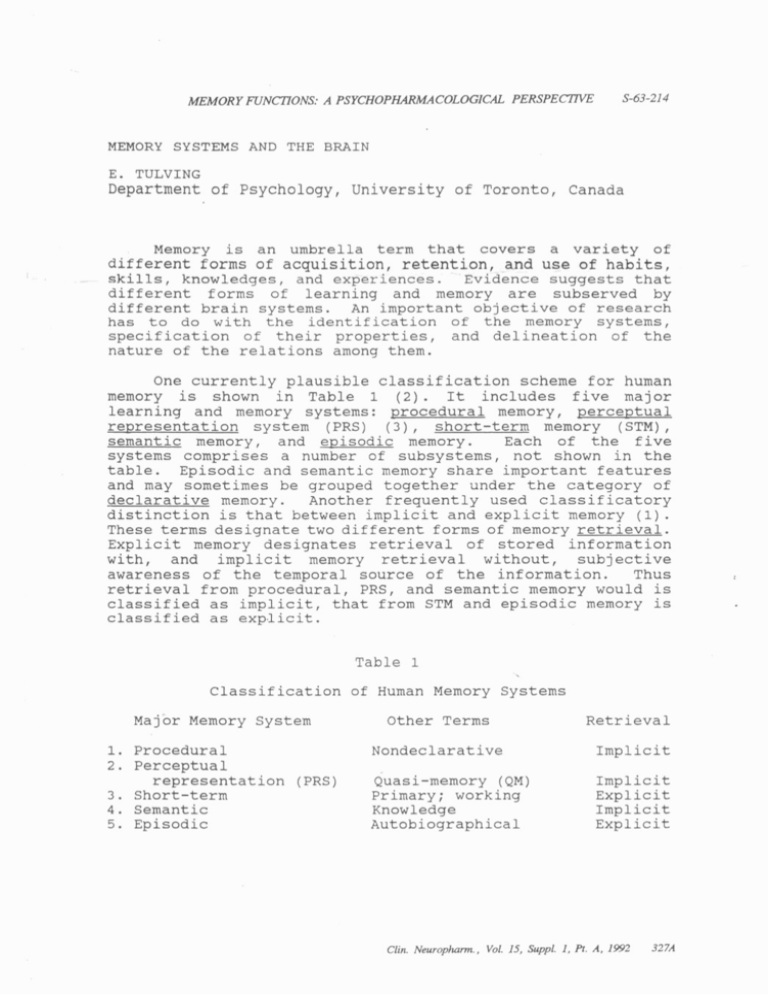
MEMORY FUNCIIONS: A PSYCHOPHARMACOLOGICAL PERSPECTNE S-63-214 MEMORY SYSTEMS AND THE BRAIN E. TULVING Department of Psychology, University of Toronto, Canada I Memory is an umbrella term that covers a variety of different forms of acquisition, retention, and use of habits, skills, knowledqes, and experiences. Evidence suggests that different forms of learning and memory are subserved by different brain systems. An important objective of research has to do with the identification of the memory systems, specification of their properties, and delineation of the nature of the relations among them. One currently plausible classification scheme for human memory is shown in Table 1 (2). It includes five major learning and memory systems: procedural memory, perceptual representation system (PRS) ( 3 ) , short-term memory (STM), semantic memory, and episodic memory. Each of the five systems comprises a number of subsystems, not shown in the table. Episodic and semantic memory share important features and may sometimes be grouped together under the category of declarative memory. Another frequently used classificatory distinction is that between implicit and explicit memory (1). These terms designate two different forms of memory retrieval. Explicit memory designates retrieval of stored information with, and implicit memory retrieval without, subjective awareness of the temporal source of the information. Thus retrieval from procedural, PRS, and semantic memory would is classified as implicit, that from STM and episodic memory is classified as expLicit. Table 1 Classification of Human Memory Systems ~ajor Memory System 1. Procedural 2. Perceptual representation (PRS) 3. Short-term 4. Semantic 5. Episodic Other Terms Retrieval Nondeclarative Implicit ~uasi-memory (QM) Primary; working Knowledge Autobiographical Implicit Explicit Implicit Explicit Clin. Neuropham., Vol. 15, Suppl. I , Pt. A, 1992 327A S-63-214 18th COLLEGIUM IhTERNAI!ONALE h'EUR0-PSYCHOPHrlRMACOLOGICUM The procedural system is an action system, its operations are expressed in behavior, independently of cognition. The other four are coqnitive systems. PRS is critically involved in perceptual identification of objects and in perceptual priming, the enhancement of such identification through experience. Short-term memory, also referred to as primary memory or workinq memory, registers and retains cognitive information in a special state of readiness and accessibility, for a short period of time after its registration in the system. Semantic memory makes possible the acquisition and retention of factual information about the world in the broadest sense; it also mediates conceptual priming. Finally, episodic memory enables individuals to remember their personal past, that is, consciously recollect experienced events as embedded in a matrix of other happenings in subjective time. Evidence relevant to memory systems is provided by converqinq dissociations between outcomes of different memory tasks. These dissociations are revealed in studies with normal subjects, in comparisons between brain-damaged and healthy subjects, across stages of development, as well as by pharmacological studies and analyses. A great deal of effort in current experimental and theoretical work is directed at the study of priminq, especially perceptual priming, the recently discovered, nonconscious, early, presemantic form of perceptual learning. Neuroanatomical correlates and neurophysiological mechanisms of different forms of human learning and memory are still largely unknown, and the available evidence is indirect. This evidence does suggest that the medial temporal lobe structures play a role in episodic and semantic memory, that extrastriate occipital regions may be involved in perceptual priming, and that prefrontal regions probably participate in the operations of episodic memory. Pharmacological studies have already begun, and will continue, to make a significant contribution to the understanding of different forms of learning and memory, and to the brain systems subserving them. REFERENCES 1. Schacter, D.L. (1990): In Development and neural bases of hiqher coqnitive functions, A. Diamond, ed., pp. 5 4 3 571. Annals of the New York Academy of Sciences, Vol. 608. (1992): In L. Squire et al., eds., Memory: Orsanization and locus of chanse (pp. 3-32). New York: Oxford University Press. 2. Tulving, E. 3. Tulving, E., and Schacter, D.L. 306. 328A Clin. Neuropharm., Vol. 15, Suppl. 1, Pr. A, 1592 (1990): Science, 247: 301-

